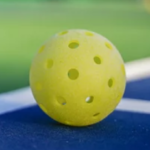I have been actively playing double pickleball for over five years.
But, my experience with single pickleball was rather limited. One day we found ourselves short two players.
So, I did an extensive research to learn the rules of single pickleball.
Pickleball rules for singles are like doubles, with some individual considerations.
Let’s explore the rules for singles playing pickleball. We’ll cover serving, scoring, faults, and boundaries.
Let’s dive in and navigate the exciting world of pickleball singles!
Table of Contents

#1 – What are the 10 key rules for single pickleball?
- Serving:
- The server must start behind the baseline and serve diagonally to the opponent’s service court.
- The serve must clear the non-volley zone (kitchen) and land within the opponent’s service court.
- Scoring:
- Only the serving side can score points.
Players score points on each serve, and they play games to 11 points, winning by 2.
- Only the serving side can score points.
- Double Bounce Rule:
- Before players can volley, they must allow the ball to bounce once on both the serving and receiving sides
- Non-Volley Zone (Kitchen):
- Players cannot volley (hit the ball in the air without letting it bounce) while standing in the non-volley zone.
- The non-volley zone extends 7 feet (2.13 meters) from the net on both sides of the court.
- Foot Faults:
- Players must be cautious about foot faults. Ensuring that no part of their foot is on or over the non-volley zone line during a volley.
- Serve Rotation:
- After scoring a point, the server moves to the other side of the court and serves to the other service court.
- Receiver’s Position:
- The player receiving the serve must stand behind the baseline. They may return the serve from anywhere behind the baseline.
- Out-of-Bounds:
- If a ball lands outside the court boundaries, the opponent is awarded the point.
- Faults:
- Common faults include: volleys in the non-volley zone, foot faults, and other rule violations.
- The opponent is awarded a point as a result of a fault
- Winning the Game:
- The first player to reach 11 points (winning by 2) wins the game. Matches are usually played as best-of-three games.
In conclusion, following the rules for serving in singles pickleball is crucial for fairness and enjoyment. It allows players to compete within set boundaries and showcase their skills.
#2 – How do you keep score in singles pickleball?
To keep score, each time a player wins a rally or scores a point, they earn one point added to their overall score. The server always announces their score first followed by their opponent’s score.
It is important to note that during singles play, only one player can score points at any given time. This is because each rally involves only two players on opposite sides of the court.
#3 – How many points in a singles pickleball game?
In singles pickleball, reaching 11 points wins the game with at least a 2-point lead over the opponent.
If both players are tied at 10-10 (known as “deuce”), the game continues until one player leads by two clear points.
Players score points when they either fail to return the ball within their opponent’s court boundaries or commit a fault.
#4 – Are there faults in singles pickleball?
Yes, and below are the list of faults.
- The serve does not land within the correct service box.
- The ball touches any part of the non-volley zone (also known as “the kitchen”) during a serve.
- A player fails to hit the ball before it bounces twice on their side.
- The ball goes out of bounds or touches any line except during serves.
#5 – Is there a second serve in singles pickleball?
Yes, in singles pickleball, players have two chances to serve the ball correctly.
For example, if a player fails to make a successful first serve, they get a second chance to try again.
Understanding serving rules is important for a successful match.
This rule ensures fairness and equal opportunities for both players
#6 – What is the double bounce rule in pickleball singles?
The double bounce rule in pickleball singles states that both players must let the ball bounce once on each side of the net before they can volley it.
This rules promotes longer rallies and tests players’ agility, reflexes, and shot-making abilities.
It also adds a strategic component to the game.
#7 – What happens if a ball hits the non-volley zone during a singles game?
In singles pickleball, if the ball hits the non-volley zone* during a rally. It results in a fault and the opponent gets the point. (*known as the kitchen)
Here are the key rules on the non-volley zone in singles play:
- Volleying from the Non-Volley Zone:
A player cannot volley* while standing in the non-volley zone. (*Hit the ball in the air without letting it bounce)
- Foot Faults:
Players must also be cautious about foot faults when in the non-volley zone. A foot fault occurs if any part of the player’s foot is on or over the non-volley zone line during the volley.
- Faults and Point Award:
If a player violates the non-volley zone rules by volleying from within the zone or committing a foot fault, it results in a fault, and the opponent is awarded a point.
Players should be mindful of their position on the court and the non-volley zone rules to avoid faults and ensure fair play during a singles pickleball match.
#8 – Are there any specific rules regarding player rotation in pickleball singles?
There are no specific rules on player rotation during a point.
Unlike in doubles play, where both players on a team must follow a specific serving and receiving order.
Since it’s an individual game, there is no need for players to rotate positions or adhere to a specific order during the point.
In singles, to start a point a server always serves from the right side of the court to the opponent’s diagonal.
Players can move freely within their respective service areas and the non-volley zone after the serve.
#9 – Do you need to switch sides after each serve in singles pickleball?
Players do NOT need to switch sides after each serve in singles pickleball
Contrary to popular belief, the serving player remains in the right-hand service box. This is throughout the entire game until they lose their serve.
On the other hand, the receiving player stays in the left-hand service box.
Players can focus on improving their skills and tactics. Without burdening the player with unnecessary side switches.
#10 – Is the serving different in singles pickleball compared to doubles?
Yes, the serving technique in singles pickleball can be different from doubles. Primarily due to the court dimensions and strategic considerations. Here are some key differences:
- Court Position:
In doubles, players serve diagonally from one side of the court to the opposite diagonal side. Both players on the serving team have designated service areas.
In singles, the server stands behind the baseline and serves to the opponent’s diagonal service court.
- Serve Location:
In doubles, the server must serve from the right side if their team’s score is even and from the left side if it’s odd.
In singles, there is no specific rule about which side to serve from based on the score.
- Target Area:
In doubles, players often aim for the opponent’s weaker side or exploit the space between them.
In singles, players needs to focus on serving to the corners of the service box. To make it more challenging for the opponent to return.
- Movement:
In doubles, both players on the serving team might move forward to take up net positions after the serve.
In singles, the server usually stays at the baseline and prepares for the next shot.
- Strategy:
In doubles serving often involves strategic placement to set up the net player for an advantageous position.
In singles, serving strategy may involve varying placement to keep the opponent guessing. And potentially induce errors.
More Questions People are Asking on Pickleball Rules for Singles

– Can you play pickleball with just 2 people?
Yes, it is possible to play pickleball with two people.
In fact, players can engage in various formats of pickleball, such as singles and doubles.
While doubles is common in pickleball, singles offers an exciting one-on-one match.
Pickleball court dimensions stay the same for two-player games as in doubles play.
The only difference is that each player covers their respective side of the court.
This means that players will have more ground to cover and will need to be quick on their feet.
– What does skinny singles mean in pickleball?
The term “skinny singles” describes a distinctive playing style where singles is played on a narrower court.
Skinny singles are gaining popularity among pickleball enthusiasts. As it adds an extra level of challenge and strategy to the game.
The court is reduced in width, by using temporary lines or markers to create a narrower playing area.
This makes players adjust their shots and footwork, demanding greater precision and control in their game play.
The concept of skinny singles offers a unique twist on traditional pickleball, allowing players to test their skills in a different setting.
It requires players to be more strategic with shot placement and movement on the court, as there is less room for error.
– Are there any specific court dimensions for pickleball singles?
In pickleball, the court dimensions for singles play are the same as for doubles play.
The official pickleball court dimensions, according to the USA Pickleball (USAPA) rules, are:
- Court Length: 44 feet (13.41 meters)
- Court Width: 20 feet (6.10 meters)
– How do you play singles pickleball?
In pickleball, the court dimensions for singles play are the same as for doubles play.
Playing singles in pickleball requires a unique set of skills and strategies. Whether you’re new to the sport or looking to improve your game, understanding the fundamentals of playing singles is crucial.
To start, positioning on the court is key. As a singles player, you have the entire court to cover, so it’s important to stay mobile and be ready for any shot.
Keep in mind that maintaining a balanced stance will allow for quick movement and better shot execution.
Additionally, when serving in singles pickleball, aim for consistency and accuracy.
A well-placed serve can put your opponent on the defensive right from the start.
Experiment with different serving techniques such as a deep serve or a low slice serve to keep your opponent guessing.
Lastly, during rallies, it’s essential to maintain good court coverage while being mindful of shot selection.
Aim for shots that force your opponent into difficult positions or create opportunities for you to attack.
Mixing up your shots with dinks, drives, and lobs can help keep your opponent off balance.
For detailed information on pickleball rules for singles, CLICK HERE.
Bottom Line
Knowing the basic rules for singles pickleball with good sportsmanship are important. For a fair and enjoyable experience games.
Understanding the scoring differences between singles and doubles enhances pickleball with both formats.
Grasping these rules enhances your enjoyment of the sport, whether you’re competing alone or as part of a team.
What to do next?
Be sure to learn all the rules and regulations of both double and single play.
Also, it is great to get to know most pickleball terms.



2 thoughts on “The 10 Best Pickleball Rules for Singles – The Ultimate Guide”
Comments are closed.